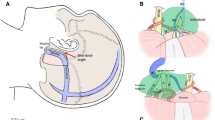Abstract
Background
Petroclival meningiomas pose significant surgical challenges because of their deep location and complex surrounding neurovasculature. The use of multiple surgical approaches can optimize safe tumor removal from multiple anatomic compartments.
Method
We describe a patient with a growing superior petroclival meningioma centered at the posterior clinoid with extension into Meckel’s cave that was successfully removed with a combined retrosigmoid and subtemporal middle fossa approach. This strategy avoided the need for anterior petrous bone drilling and tentorial splitting.
Conclusion
A combined retrosigmoid and subtemporal middle fossa approach can provide safe access to tumors spanning the supra- and infratentorial compartments.



Similar content being viewed by others
Data availability
Not applicable.
Code availability
Not applicable.
References
Bambakidis NC, Kakarla UK, Kim LJ, Nakaji P, Porter RW, Daspit CP, Spetzler RF (2007) Evolution of surgical approaches in the treatment of petroclival meningiomas: a retrospective review. Neurosurgery 61:202–209. https://doi.org/10.1227/01.neu.0000303218.61230.39. (discussion 209-211)
Chen LF, Yu XG, Bu B, Xu BN, Zhou DB (2011) The retrosigmoid approach to petroclival meningioma surgery. J Clin Neurosci 18:1656–1661. https://doi.org/10.1016/j.jocn.2011.03.027
Couldwell WT, Fukushima T, Giannotta SL, Weiss MH (1996) Petroclival meningiomas: surgical experience in 109 cases. J Neurosurg 84:20–28. https://doi.org/10.3171/jns.1996.84.1.0020
Di Carlo DT, Capo G, Fava A, Cagnazzo F, Margil-Sànchez M, Champagne PO, Voormolen EHJ, Morganti R, Froelich S, Perrini P (2020) Petroclival meningiomas: the risk of post-operative cranial nerve deficits among different surgical approaches-a systematic review and meta-analysis. Acta Neurochir (Wien) 162:2135–2143. https://doi.org/10.1007/s00701-020-04395-6
Diaz Day J (2012) The middle fossa approach and extended middle fossa approach: technique and operative nuances. Neurosurgery 70:192–201. https://doi.org/10.1227/NEU.0b013e31823583a1
Gonzalez LF, Crawford NR, Horgan MA, Deshmukh P, Zabramski JM, Spetzler RF (2002) Working area and angle of attack in three cranial base approaches: pterional, orbitozygomatic, and maxillary extension of the orbitozygomatic approach. Neurosurgery 50:550–555
Lawton MT, Daspit CP, Spetzler RF (1996) Transpetrosal and combination approaches to skull base lesions. Clin Neurosurg 43:91–112
Seoane E, Rhoton AL (1999) Suprameatal extension of the retrosigmoid approach: microsurgical anatomy. Neurosurgery 44:553–560. https://doi.org/10.1097/00006123-199903000-00065
Zhao Z, Yuan X, Yuan J, Cai L, Jiang W, Xie Y, Wanggou S, Zhang C, Tang G, Li H, Peng Z, Li X, Liu Q (2020) Treatment strategy for petroclival meningiomas based on a proposed classification in a study of 168 cases. Sci Rep 10:4655. https://doi.org/10.1038/s41598-020-61497-y
Zhu W, Mao Y, Zhou LF, Zhang R, Chen L (2008) Combined subtemporal and retrosigmoid keyhole approach for extensive petroclival meningiomas surgery: report of experience with 7 cases. Minim Invasive Neurosurg 51:95–99. https://doi.org/10.1055/s-2007-1022551
Author information
Authors and Affiliations
Contributions
Robert C. Rennert: methodology, writing-original draft, visualization.
Karol P. Budohoski: writing-review and editing.
Vance R. Mortimer: visualization, writing-review and editing.
William T. Couldwell: conceptualization, resources, supervision, project administration, writing-review and editing.
Corresponding author
Ethics declarations
Ethical approval
Approval from the institutional review board is waived for case reports. All procedures performed in studies involving human participants were in accordance with the ethical standards of the University of Utah and with the 1964 Helsinki declaration and its later amendments or comparable ethical standards.
Consent to participate
The patient consented to participate.
Consent for publication
The patient consented to the publication of her case in this paper.
Competing interests
The authors declare no competing interests.
Additional information
Publisher's Note
Springer Nature remains neutral with regard to jurisdictional claims in published maps and institutional affiliations.
Key points
• Petroclival tumors often span anatomic compartments and can require multiple surgical approaches.
• Familiarity with the limits of described approaches to the petroclival region is critical.
• The combined retrosigmoid and subtemporal middle fossa approach provides multicompartment access.
• The retrosigmoid approach provides access along the long axis of the tumor up to the level of the posterior clinoid.
• Drilling of the suprameatal tubercle can widen the retrosigmoid corridor.
• The middle fossa approach provides access to Meckel’s cave without anterior petrous removal and transgression of the tentorium.
• Avoiding tentorial splitting limits risk to the trochlear nerve.
• Maintenance of a bony bridge on the transverse-sigmoid junction minimizes risk of venous injury.
• Watertight dural closure, fat grafting, and cerebrospinal fluid drainage can reduce the risk of wound complications.
• The patient should understand the risks of petroclival tumor surgery and need for follow-up.
Supplementary Information
Below is the link to the electronic supplementary material.
Supplementary file1 (MP4 100995 KB)
Rights and permissions
Springer Nature or its licensor (e.g. a society or other partner) holds exclusive rights to this article under a publishing agreement with the author(s) or other rightsholder(s); author self-archiving of the accepted manuscript version of this article is solely governed by the terms of such publishing agreement and applicable law.
About this article
Cite this article
Rennert, R.C., Budohoski, K.P., Mortimer, V.R. et al. Combined retrosigmoid and middle fossa approach for a small, superiorly located petroclival meningioma: how I do it. Acta Neurochir 165, 2931–2935 (2023). https://doi.org/10.1007/s00701-023-05775-4
Received:
Accepted:
Published:
Issue Date:
DOI: https://doi.org/10.1007/s00701-023-05775-4




